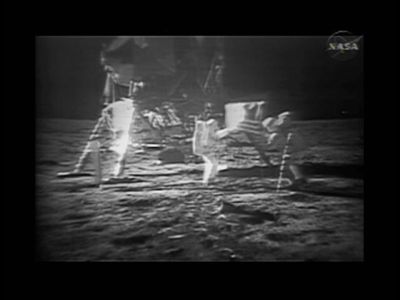NASA lost video of moon landing

WASHINGTON – NASA could put a man on the moon, but it didn’t have the sense to keep the original video of the live TV transmission.
In an embarrassing acknowledgment, the space agency said Thursday that it must have erased the Apollo 11 moon footage years ago so that it could reuse the videotape.
But now Hollywood is coming to the rescue.
The studio wizards who restored “Casablanca” are digitally sharpening and cleaning up the ghostly, grainy footage of the moon landing, making it even better than what TV viewers saw on July 20, 1969. They are doing it by working from four copies that NASA scrounged from around the world.
“There’s nothing being created; there’s nothing being manufactured,” said NASA senior engineer Dick Nafzger, who is in charge of the project. “You can now see the detail that’s coming out.”
The first batch of restored footage was released just in time for the 40th anniversary of the “one giant leap for mankind,” and some of the details seem new because of their sharpness. Originally, astronaut Neil Armstrong’s face visor was too fuzzy to be seen clearly. The upgraded video of Earth’s first moonwalker shows the visor and a reflection in it.
Only 40 percent of the work has been done on the $230,000 refurbishing effort. But it does show improvements in four snippets: Armstrong walking down the ladder; Buzz Aldrin following him; the two astronauts reading a plaque they left on the moon; and the planting of the flag on the lunar surface.
Nafzger said a search that began three years ago for the old moon tapes led to the “inescapable conclusion” that 45 tapes of Apollo 11 video were erased and reused. His report on that will come out in a few weeks.
The original videos beamed to Earth were stored on giant reels of tape that each contained 15 minutes of video, along with other data from the moon. In the 1970s and ’80s, NASA had a shortage of the tapes, so it erased about 200,000 of them and reused them.
Nafzger, who was in charge of the live TV recordings back in the Apollo years, said they were mostly thought of as data tapes. It wasn’t his job to preserve history, he said, just to make sure the footage worked. In retrospect, he said, he wished NASA hadn’t reused the tapes.
Rice University historian and author Douglas Brinkley noted that NASA saved all sorts of data and artifacts from Apollo 11. He said it was “mind-boggling” that the tapes were gone.
“It’s surprising to me that NASA didn’t have the common sense to save perhaps the most important historical footage of the 20th century,” he said. The remastered copies may look good, but “when dealing with historical film footage, you always want the original to study.”
The company that restored all the Indiana Jones movies is the one bailing out NASA.
Lowry Digital of Burbank, Calif., noted that “Casablanca” had a pixel count 10 times higher than the moon video, meaning the Apollo 11 footage was fuzzier than that vintage movie and more of a challenge in one sense. Of all the video the company has dealt with, “this is by far and away the lowest quality,” said Lowry President Mike Inchalik.
The Apollo 11 video remains in black and white.
The restoration used four video sources: CBS News originals; kinescopes from the National Archives; a video from Australia that received the transmission of the original moon video; and camera shots of a TV monitor.
Both Nafzger and Inchalik acknowledged that digitally remastering the video could further encourage conspiracy theorists who believe NASA faked the entire moon landing on a Hollywood set. But they said they enhanced the video as conservatively as possible. Besides, Inchalik said, if there had been a conspiracy to fake a moon landing, NASA surely would have created higher-quality film.